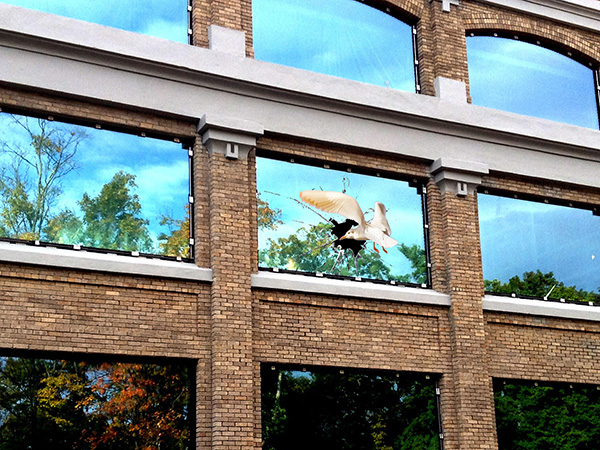I’ve invited Christine Sheppard, Ph.D. to give a talk at Cornell on Friday, Nov. 2, 2018 at 4:45 pm in 101 West Sibley Hall on the subject of bird-friendly design. The talk is open to the public and free. Continuing education credit (one LU/HSW credit) is available for architects and LEED APs or Green Associates.

Rand Hall at Cornell University (photo and PhotoShopped window and bird by Jonathan Ochshorn, Oct. 2018)
Title: Bird-Friendly Building Design
Speaker: Christine Sheppard, Ph.D., Director, Glass Collisions Program, American Bird Conservancy
Date, time, and place: Friday, November 2, 2018, 4:45 pm in 101 West Sibley Hall, Cornell University
Abstract: Birds are potent cultural symbols. They play fundamental roles in ecosystems and habitat regeneration and are important natural controls for insects. Hundreds of millions are killed yearly by colliding with glass in the US alone. Birds cannot see glass, striking it as they fly towards reflections of clouds, sky and vegetation or as they approach real habitat seen through glass. Birds collide with glass on structures of every size, from shacks to skyscrapers, in urban, suburban and rural area. Advances in technology are increasing use of glass curtain walls and other large glass features, increasing the rate of mortality.
Until recently, this problem has been almost unrecognized as an issue of sustainability. However, the Green Building Council has responded by adding a Pilot Credit, Reducing Bird Mortality, to the LEED rating system. Toronto, San Francisco, Oakland and the state of Minnesota now mandate bird-friendly construction in some cases and more legislation and voluntary guidelines are pending. Moving into the future it will be increasingly necessary to design structures with impact on birds in mind.
This class explains how to recognize hazards to birds in the built environment. Case studies and a slide show illustrate many currently available strategies for reducing bird mortality and how bird-friendly design can add value to strategies often deployed to control heat and light or promote security. We review use of the LEED credit and important features of legislation. Techniques now in use for evaluating the relative threat level to birds of different materials are described, along with typical results.
Continuing education credits: Available for registered architects/engineers as well as LEED APs and Green Associates.
Short bio: Christine Sheppard earned her B.A. and Ph.D. in Ecology and Evolutionary Biology at Cornell University. Working with Dr. Tom Cade, who used captive breeding to restore the Peregrine Falcon to the eastern US, developed her interest in captive propagation as a tool to save endangered species. This led her to the Wildlife Conservation Society’s Bronx Zoo, where she started as curatorial intern, in 1978, and ended as Curator and Chair of the Ornithology Department. Zoos deal not only with issues of their buildings causing mortality of wild birds. Glass exhibit walls, windows and handrails bring bird collision problems inside and curators have a vested interest in finding ways to make glass safe for birds. Interest in the issue led to Dr. Sheppard to join the board of the Bird-safe Glass Foundation as science advisor, in 2007; she became President in 2017. She is also conducting basic research into quantifying the effectiveness of different materials and patterns in preventing bird collisions. In 2009, she moved to the American Bird Conservancy as Collisions Program Director. She authored both editions of ABC’s publication, Bird-friendly Building Design. She has also created AIA/LEED continuing education classes on Bird-friendly Design. She helped create San Francisco’s Standards for Bird-safe Buildings and has subsequently been involved in creating code and legislation in many different jurisdictions. She led the team that developed USGBC LEED Pilot Credit 55: Reducing Bird Mortality. She was named an Engineering News-Record Top 25 Newsmaker for 2014 because of her work on glass testing and has worked with most major glass manufacturers on design and evaluation of bird-friendly materials.
